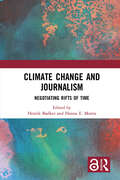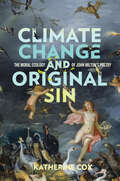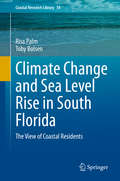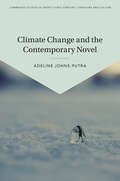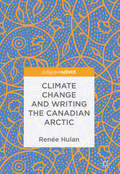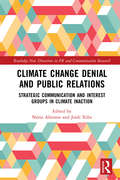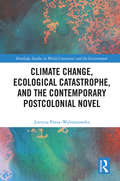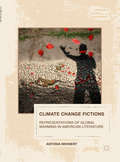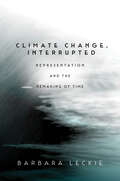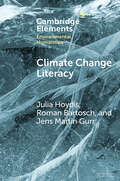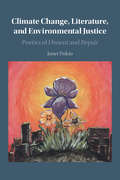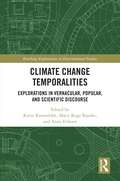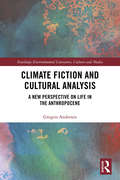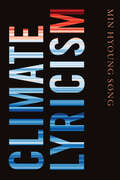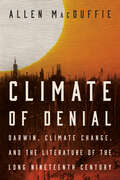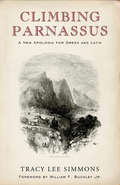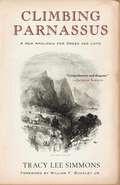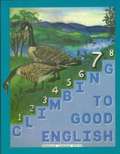- Table View
- List View
Climate Change and Journalism: Negotiating Rifts of Time
by Henrik BødkerThis edited collection addresses climate change journalism from the perspective of temporality, showcasing how various time scales—from geology, meteorology, politics, journalism, and lived cultures—interact with journalism around the world. Analyzing the meetings of and schisms between various temporalities as they emerge from reporting on climate change globally, Climate Change and Journalism: Negotiating Rifts of Time asks how climate change as a temporal process gets inscribed within the temporalities of journalism. The overarching question of climate change journalism and its relationship to temporality is considered through the themes of environmental justice and slow violence, editorial interventions, ecological loss, and political and religious contexts, which are in turn explored through a selection of case studies from the US, France, Thailand, Brazil, Australia, Spain, Mexico, Canada, and the UK. This is an insightful resource for students and scholars in the fields of journalism, media studies, environmental communication, and communications generally.
Climate Change and Original Sin: The Moral Ecology of John Milton's Poetry (Under the Sign of Nature)
by Katherine CoxPrior to the Enlightenment era, how was the human-climate relationship conceived? Focusing on the most recent epoch in which belief in an animate environment still widely prevailed, Climate Change and Original Sin argues that an ecologically inflected moral system assumed that humanity bore responsibility for climate corruption and volatility.The environmental problem initiated by original sin is not only that humans alienated themselves from nature but also that satanic powers invaded the world and corrupted its elements—particularly the air. Milton shared with contemporaries the widespread view that storms and earthquakes represented the work of fearsome spiritual agents licensed to inflict misery on humans as penalty for sin. Katherine Cox’s work discerns in Paradise Lost an ecological fall distinct from, yet concurrent with, the human fall. In examining Milton’s evolving representations of the climate, this book also traces the gradual development of ideas about the atmosphere during the seventeenth century—a change in the intellectual climate driven by experimental activity and heralding an ecologically devastating shift in Western attitudes toward the air.
Climate Change and Sea Level Rise in South Florida: The View of Coastal Residents (Coastal Research Library #34)
by Risa Palm Toby BolsenSouth Florida is frequently cited as the part of the United State of America as most susceptible to the devastation accompanying sea level rise. Several scholarly studies have shown the negative impact of coastal location in Florida on housing values. Are the residents of South Florida concerned? Is susceptibility to sea level rise actually affecting the housing market in terms of demand, the availability of home mortgages, or house prices? Are people living at particular risk from sea level rise aware of this risk and more open to new information about climate change? Do they support policies and laws to mitigate the pace and extent of climate change? Answers to these questions are not only of general interest, but they are also key to our understanding of the human dimensions of this problem. This book describes the results of a detailed survey in which respondents viewed a local map displaying flooding to their own community that would result from a Category 3 hurricane in 2033. It discusses political party identification and ideology that has an overwhelming impact in shaping views about sea level rise and climate change. This book has enormous implications for the effectiveness of communicating risk information. The text is important if we, as a nation, are to design communication strategies that will lead to broader policy to combat or mitigate this risk.
Climate Change and the Contemporary Novel (Cambridge Studies in Twenty-First-Century Literature and Culture)
by Adeline Johns-PutraClimate change is becoming a major theme in the contemporary novel, as authors reflect concerns in wider society. Given the urgency and enormity of the problem, can literature (and the emotional response it provokes) play a role in answering the complex ethical issues that arise because of climate change? This book shows that conventional fictional techniques should not be disregarded as inadequate to the demands of climate change; rather, fiction has the potential to challenge us, emotionally and ethically, to reconsider our relationship to the future. Adeline Johns-Putra focuses on the dominant theme of intergenerational ethics in the contemporary novel: that is, the idea of our obligation to future generations as a basis for environmental action. Rather than simply framing parenthood and posterity in sentimental terms, the climate change novel uses their emotional appeal to critique their anthropocentricism and identity politics, offering radical alternatives instead.
Climate Change and Writing the Canadian Arctic
by Renée HulanClimate Change and Writing the Canadian Arctic explores the impact of climate change on Canadian literary culture. Analysis of the changing rhetoric surrounding the discovery of the lost ships of the Franklin expedition serves to highlight the political and economic interests that have historically motivated Canada’s approach to the Arctic and shaped literary representations. A recent shift in Canadian writing away from national sovereignty to circumpolar stewardship is revealed in detailed close readings of Kathleen Winter’s Boundless and Sheila Watt-Cloutier’s The Right to Be Cold.
Climate Change Denial and Public Relations: Strategic communication and interest groups in climate inaction (Routledge New Directions in PR & Communication Research)
by Núria Almiron Jordi XifraThis is the first book on climate change denial and lobbying that combines the ideology of denial and the role of anthropocentrism in the study of interest groups and communication strategy. Climate Change Denial and Public Relations: Strategic Communication and Interest Groups in Climate Inaction is a critical approach to climate change denial from a strategic communication perspective. The book aims to provide an in-depth analysis of how strategic communication by interest groups is contributing to climate change inaction. It does this from a multidisciplinary perspective that expands the usual approach of climate change denialism and introduces a critical reflection on the roots of the problem, including the ethics of the denialist ideology and the rhetoric and role of climate change advocacy. Topics addressed include the power of persuasive narratives and discourses constructed to support climate inaction by lobbies and think tanks, the dominant human supremacist view and the patriarchal roots of denialists and advocates of climate change alike, the knowledge coalitions of the climate think tank networks, the denial strategies related to climate change of the nuclear, oil, and agrifood lobbies, the role of public relations firms, the anthropocentric roots of public relations, taboo topics such as human overpopulation and meat-eating, and the technological myth. This unique volume is recommended reading for students and scholars of communication and public relations.
Climate Change, Ecological Catastrophe, and the Contemporary Postcolonial Novel (Routledge Studies in World Literatures and the Environment)
by Justyna Poray-WybranowskaClimate Change, Ecological Catastrophe, and the Contemporary Novel responds to the critical need for transdisciplinary research on the relationship between colonialism and catastrophe. It represents the first sustained analysis of the connection between colonial legacy and present-day ecological catastrophe in postcolonial fiction. Analyzing contemporary South Asian and South Pacific novels that grapple with climate change and catastrophe, environmental exploitation and instability, and human-nonhuman relationships in degraded environments, it offers a much-needed corrective to dominant narratives about climate, crisis, and the everyday. Highlighting the contributions of literary fiction from the postcolonial South to the growing field of the environmental humanities, this book reconsiders the novel’s relationship with climate change and the contemporary environmental imaginary. Counter to dominant current theoretical discourses, it demonstrates that the novel form is ideally suited to literary and imaginative engagements with climate change and ecological catastrophe. The six case studies it examines connect contemporary ecological vulnerability to colonial legacies, reveal the critical role animals and the environment play in literary imaginations of post-catastrophe recovery, and together constellate a decolonial perspective on ecological catastrophe in the era of climate change. Drawing on the work of Indigenous authors and scholars who write about and against the Anthropocene, this book displaces conventional ways of thinking about the relationship between the mundane and the catastrophic and promotes greater dialogue between the largely siloed fields of postcolonial, Indigenous, and disaster studies.
Climate Change Fictions: Representations of Global Warming in American Literature (Literatures, Cultures, and the Environment)
by Antonia MehnertThis book highlights the importance of the cultural sphere, and in particular literature, in response and discussion with the unprecedented phenomenon known as climate change. Antonia Mehnert turns to a set of contemporary American works of fiction, reading them as a unique response to the challenges of representing climate change. She draws on "climate change fiction"-- texts dealing explicitly with anthropogenic climate change--and explores how these works convey climate change, deal with its challenging characteristics, and with what narrative techniques they ultimately participate in its communication. Indeed, a number of challenging traits make climate change a difficult issue to engage with including its slow and long temporal dimension, global scale, scientific controversy, and its disconnect between cause and effect. Considering such complexity and uncertainty at the source of climate change fictions, this book moves beyond a solely ecocritical analysis and shows how these climate change fictions constitute an insightful cultural repertoire valuable for discussion in the environmental humanities in general.
Climate Change, Interrupted: Representation and the Remaking of Time
by Barbara LeckieIn this moment of climate precarity, Victorian studies scholar Barbara Leckie considers the climate crisis as a problem of time. Spanning the long nineteenth century through our current moment, her interdisciplinary treatment of climate change at once rethinks time and illustrates that the time for climate action is now. Climate Change, Interrupted argues that linear, progress-inflected temporalities are not adequate to a crisis that defies their terms. Instead, this book advances a theory and practice of interruption to rethink prevailing temporal frameworks. At the same time, it models the anachronistic, time-blending, and time-layering temporality it advances. In a series of experimental chapters informed by the unlikely trio of Walter Benjamin, Donna Haraway, and Virginia Woolf, Leckie reinflects and cowrites the traditions and knowledges of the long nineteenth century and the current period in the spirit of climate action collaboration. The current moment demands as many approaches as possible, invites us to take risks, and asks scholars and activists adept at storytelling to participate in the conversation. Climate Change, Interrupted, accordingly, invests in interruption to tell a different story of the climate crisis.
Climate Change Literacy (Elements in Environmental Humanities)
by Julia Hoydis Roman Bartosch Jens Martin GurrThis Element presents a necessary intervention within the rapidly expanding field of research in the environmental humanities on climate change and environmental literacy. In contrast to the dominant, science-centred literacy debates, which largely ignore the unique resources of the humanities, it asks: How does literary reading contribute to climate change communication? How does this contribution relate to recent demands for environmental and related literacies? Rather than reducing the function of literature to a more pleasurable form of information transfer or its affective dimension of evoking sympathy, climate change literacy thoroughly reassesses the cognitive, affective, and pedagogic potentials of literary writing. It does so by analysing a selection of popular climate novels and by demonstrating the role of fiction in fostering a more adequate understanding of, and response to, climate change. This title is also available as Open Access on Cambridge Core.
Climate Change, Literature, and Environmental Justice: Poetics of Dissent and Repair
by Janet FiskioPlacing climate change within the long histories of enslavement, settler colonialism, and resistance, Climate Change, Literature, and Environmental Justice: Poetics of Dissent and Repair examines the connections between climate disruption and white supremacy. Drawing on decolonial and reparative theories, Janet Fiskio focuses on expressive cultures and practices, such as dance, protests, and cooking, in conversation with texts by Kazim Ali, Octavia Butler, Louise Erdrich, Winona LaDuke, Mark Nowak, Simon Ortiz, Jesmyn Ward, and Colson Whitehead. Through an exploration of speculative pasts and futures, practices of dissent and mourning, and everyday inhabitation and social care, Climate Change, Literature, and Environmental Justice illuminates the ways that frontline communities resist environmental racism while protecting and repairing the world.
Climate Change Temporalities: Explorations in Vernacular, Popular, and Scientific Discourse (Routledge Explorations in Environmental Studies)
by Kyrre Kverndokk, Marit Ruge Bjærke, and Anne EriksenClimate Change Temporalities explores how various timescales, timespans, intervals, rhythms, cycles, and changes in acceleration are at play in climate change discourses. It argues that nuanced, detailed, and specific understandings and concepts are required to handle the challenges of a climatically changed world, politically and socially as well as scientifically. Rather than reflecting abstractly on theories of temporality, this edited collection explores a variety of timescales and temporalities from narratives, experience, popular culture, and everyday life in addition to science and history - and the entanglements between them. The chapters are clustered into three main sections, exploring a range of genres, such as questionnaires, interviews, magazines, news media, television series, aquariums, and popular science books to critically examine how and where climate change understandings are formed. The book also includes chapters historising notions of climate and temporality by exploring scientific debates and practices. Climate Change Temporalities will be of great interest to students and scholars of humanistic climate change research, environmental humanities, studies of temporality and historicity, cultural studies, cultural history, and popular culture.
Climate Fiction and Cultural Analysis: A new perspective on life in the anthropocene (Routledge Environmental Literature, Culture and Media)
by Gregers AndersenClimate Fiction and Cultural Analysis argues that the popularity of the term "climate fiction" has paradoxically exhausted the term’s descriptive power and that it has developed into a black box containing all kinds of fictions which depict climatic events and has consequently lost its true significance. Aware of the prospect of ecological collapse as well as our apparent inability to avert it, we face geophysical changes of drastic proportions that severely challenge our ability to imagine the consequences. This book argues that this crisis of imagination can be partly relieved by climate fiction, which may help us comprehend the potential impact of the crisis we are facing. Strictly assigning "climate fiction" to fictions that incorporate the climatological paradigm of anthropogenic global warming into their plots, this book sets out to salvage the term’s speculative quality. It argues that climate fiction should be regarded as no less than a vital supplement to climate science, because climate fiction makes visible and conceivable future modes of existence within worlds not only deemed likely by science, but which are scientifically anticipated. Focusing primarily on English and German language fictions, Climate Fiction and Cultural Analysis shows how Western climate fiction sketches various affective and cognitive relations to the world in its utilization of a small number of recurring imaginaries, or imagination forms. This book will be of great interest to students and scholars of ecocriticism, the environmental humanities, and literary and culture studies more generally.
Climate Lyricism
by Min Hyoung SongIn Climate Lyricism Min Hyoung Song articulates a climate change-centered reading practice that foregrounds how climate is present in most literature. Song shows how literature, poetry, and essays by Tommy Pico, Solmaz Sharif, Frank O’Hara, Ilya Kaminsky, Claudia Rankine, Kazuo Ishiguro, Teju Cole, Richard Powers, and others help us to better grapple with our everyday encounters with climate change and its disastrous effects, which are inextricably linked to the legacies of racism, colonialism, and extraction. These works employ what Song calls climate lyricism—a mode of address in which a first-person “I” speaks to a “you” about how climate change thoroughly shapes daily life. The relationship between “I” and “you” in this lyricism, Song contends, affects the ways readers comprehend the world, fostering a model of shared agency from which it can become possible to collectively and urgently respond to the catastrophe of our rapidly changing climate. In this way, climate lyricism helps to ameliorate the sense of being overwhelmed and feeling unable to do anything to combat climate change.
Climate of Denial: Darwin, Climate Change, and the Literature of the Long Nineteenth Century
by Allen MacDuffieMany people today experience the climate crisis with a divided state of mind: aware of the extreme effects, but living everyday life as if the crisis is not actually happening. This book argues that this structure of feeling has roots that can be traced back to the nineteenth century, when Western culture encountered the profound shock of Charles Darwin's theory of evolution. Darwin's theory made it increasingly difficult for secular humanists to flatly deny that humans are animals, fully enmeshed in natural systems and processes. But like those of us confronting climate change today, many writers and scientists struggled to integrate its depersonalizing vision into their understanding of the place of humans in the natural order. The result was that the radical environmental implications of The Origin of Species were evaded as soon as they were articulated, abetted by a culture of denial structured by the illusions of capital and empire. In light of the climate emergency, Climate of Denial recontextualizes nineteenth-century texts to offer rich insight into the defensive strategies used—then and now—to avoid confronting the unsettling realities of our situation on this planet.
Climbing Parnassus: A New Apologia for Greek and Latin
by Tracy Lee SimmonsClimbing Parnassus presents the reader not so much with a program for educational renewal as with a defense and vindication of the formative power of Greek and Latin. Tracy Lee Simmons's persuasive witness to the unique, now all-but-forgotten advantages of study in, and of, the classical languages constitutes a bracing reminder of the genuine aims of a truly liberal education.
Climbing Parnassus: A New Apologia for Greek and Latin
by Tracy Lee SimmonsIn Climbing Parnassus, winner of the 2005 Paideia Prize, Tracy Lee Simmons presents a defense and vindication of the formative power of Greek and Latin. He also shows how these languages have played a crucial role in the development of authentic Humanism, the foundation of the West's cultural order and America's understanding of itself as a union of citizens. Simmons's persuasive witness to the unique, now all-but-forgotten advantages of study in and of the classical languages constitutes a bracing reminder of the genuine aims of a truly liberal education.
Climbing to Good English (Grade #2)
by SchoolaidA grammar textbook that will help pupils to study and learn how to read and write effectively.
Climbing to Good English: Grade 4 Practice Sheets
by SchoolaidThis Schoolaid Language Series is designed by Schoolaid to complement the Pathway Reader Series by extending in phonics and reading comprehension, grammar and composition.
Climbing to Good English (Grade #1)
by SchoolaidEnglish in first grade is more or less an extension of reading and phonics. Phonics helps pupils to read; English helps them to write what they or others will read. In teaching pupils to express themselves in writing, English uses the concepts taught in phonics while adding some of its own.
Climbing to Good English: Grade 6
by Rod Staff<p>Our main goal, of course, is to improve our communication skills -- to understand what we hear or read and to express ourselves clearly in speaking and writing. However, to attain these skills, we need the building blocks of grammar, mechanics, and usage. For these reasons we have begun each unit with a composition lesson in which pupils are exercised in listening, reading, evaluation, taking notes, organizing, building vocabulary, explaining, writing, editing, and rewriting. <p>Between the composition assignments, pupils are drilled on how to handle the building blocks of grammar (sentence structure, parts of speech, etc.), mechanics (punctuation and capitalization), and usage (word study). Our language series, Climbing to Good English (CGE), is different from most others on the market in that it is programmed for use in multi-grade classrooms. This means that the pupils are expected to help themselves -- do much of the work independently without much teacher help. The older a pupil becomes, the more he is expected to do this.</p>
Climbing To Good English 2
by SchoolaidClimbing To Good English Grade 2: An Extension in Phonics, Reading Comprehension, Grammar, Dictionary Skills, and Composition.
